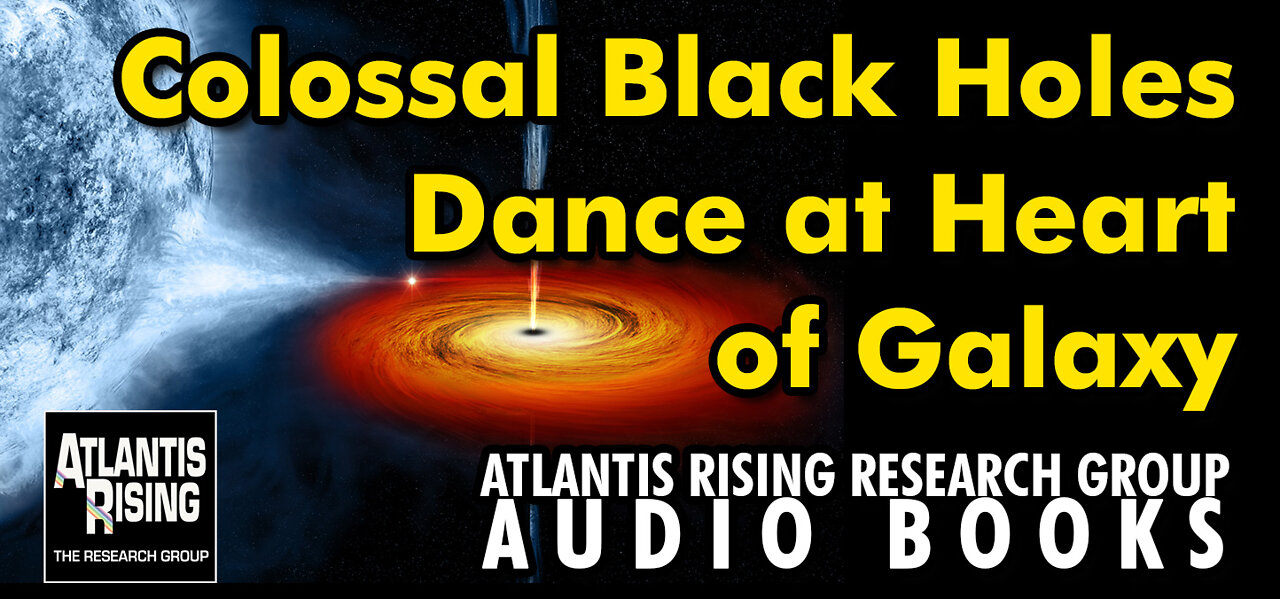Premium Only Content

Colossal Black Holes Dance at Heart of Galaxy, From Atlantis Rising Research Group
Visit Atlantis Rising Research Group at https://www.atlantisrising.com/
Colossal Black Holes Dance at Heart of Galaxy
Astronomers find evidence for the tightest-knit supermassive black hole duo observed to date
By Whitney Clavin
Locked in an epic cosmic waltz 9 billion light years away, two supermassive black holes appear to be orbiting around each other every two years. The two giant bodies each have masses that are hundreds of millions of times larger than that of our sun, and the objects are separated by a distance roughly 50 times that which separates our sun and Pluto. When the pair merge in roughly 10,000 years, the titanic collision is expected to shake space and time itself, sending gravitational waves across the universe.
A Caltech-led team of astronomers has discovered evidence for this scenario taking place within a fiercely energetic object known as a quasar. Quasars are active cores of galaxies in which a supermassive black hole is siphoning material from a disk encircling it. In some quasars, the supermassive black hole creates a jet that shoots out at near the speed of light. The quasar observed in the new study, PKS 2131-021, belongs to a subclass of quasars called blazars in which the jet is pointing toward the Earth. Astronomers already knew quasars could possess two orbiting supermassive black holes, but finding direct evidence for this has proved difficult.
Reporting in The Astrophysical Journal Letters, the researchers argue that PKS 2131-021 is a very rare candidate for a pair of supermassive black holes caught in the act of merging. The first candidate pair, within a quasar called OJ 287, orbit each other at greater distances, circling every nine years versus the two years it takes for the PKS 2131-021 pair to complete an orbit.
The telltale evidence came from radio observations of PKS 2131-021 that span 45 years. According to the study, a powerful jet emanating from one of the two black holes within PKS 2131-021 is shifting back and forth due to the pair’s orbital motion. This causes periodic changes in the quasar’s radio-light brightness. Five different observatories registered these oscillations, including Caltech’s Owens Valley Radio Observatory (OVRO), the University of Michigan Radio Astronomy Observatory (UMRAO), MIT’s Haystack Observatory, the National Radio Astronomy Observatory (NRAO), Metsähovi Radio Observatory in Finland, and NASA’s Wide-field Infrared Survey Explorer (WISE) space satellite.
The combination of the radio data yields a nearly perfect sinusoidal light curve unlike anything observed from quasars before.
“When we realized that the peaks and troughs of the light curve detected from recent times matched the peaks and troughs observed between 1975 and 1983, we knew something very special was going on,” says Sandra O’Neill, lead author of the new study and an undergraduate student at Caltech who is mentored by Tony Readhead, Robinson Professor of Astronomy, Emeritus.
Most, if not all, galaxies possess monstrous black holes at their cores, including our own Milky Way galaxy. When galaxies merge, their black holes “sink” to the middle of the newly formed galaxy and eventually join together to form an even more massive black hole. As the black holes spiral toward each other, they increasingly disturb the fabric of space and time, sending out gravitational waves, which were first predicted by Albert Einstein more than 100 years ago.
-
 0:19
0:19
Atlantis Rising Research Group
2 years agoJoin the ATLANTIS RISING RESEARCH GROUP!
1.28K2 -
 2:25:42
2:25:42
TheSaltyCracker
9 hours agoThey So Mad ReEEeStream 8-10-25
119K265 -
 2:27:39
2:27:39
vivafrei
18 hours agoEp. 276: Epstein Subpoenas &Trump E.O! Bondi Offers Reward for Maduro Arrest? MADNESS IN CANADA!
138K134 -
 2:23:55
2:23:55
Barry Cunningham
12 hours agoPRESIDENT TRUMP IS NOT PLAYING AROUND...AND THE LIBNUTS CAN'T STOP HIM!
96.5K64 -
 22:02
22:02
Stephen Gardner
18 hours ago🔥JUST IN: Trump BETRAYAL plot EXPOSED!
115K302 -
 38:32
38:32
The Why Files
21 days agoThe Real CIA Vol. 1: 693 Pages of Secret Crimes
130K60 -
 49:12
49:12
MattMorseTV
15 hours ago $22.15 earned🔴Zelenskyy is NOT HAPPY about Trump’s NEW DEAL.🔴
126K158 -
 1:03:49
1:03:49
Warren Smith - Secret Scholar Society
4 days ago"You are on the brink" - My Conversation with Nick Fuentes
91.5K64 -
 8:05
8:05
Tactical Advisor
17 hours agoNEW Best Budget AR15 | PSA Guardsman (FIRST LOOK)
82.7K29 -
 8:55
8:55
Warren Smith - Secret Scholar Society
3 days agoMatt Walsh EXPOSES a Leftist's Lie So Badly She Flees the Stage
69.9K32